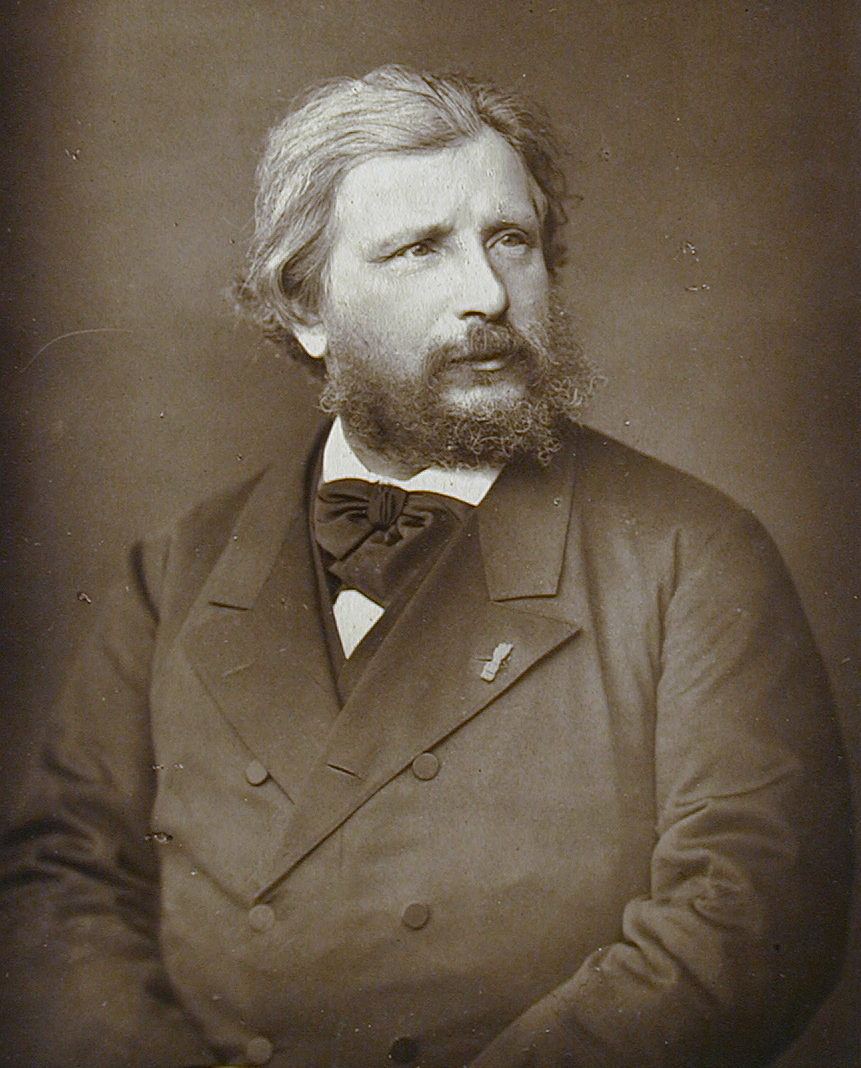More about William-Adolphe Bouguereau
- All
- Info
- Shop
Works by William-Adolphe Bouguereau

Contributor
The Impressionists thought Bouguereau was a real stick in the mud.
William-Adolphe had a fondness for tradition that didn’t click well with his rule-averse contemporaries. Despite rumors that he was as popular as the president, Bouguereau’s Impressionist peers thought him a traditionalist fossil. Degas and his posse coined the insult “bouguerated” for paintings of undesirable texture. The ever unpleasant Gauguin snidely noted that the rightful place for a Bouguereau canvas was a brothel. Van Gogh was unmoved by Bouguereau’s success, chalking his success up to being a rich artist dealing in appealing, cushy subjects. From a man who built his career on one-eared self portraits and skulls with cigarettes, this was not high praise.
Impressionism’s golden boys were aggravated by Bouguereau’s role in the salons. As a juror, he doggedly pushed to keep the avant-garde out of annual exhibitions. He also taught Matisse, but deemed the younger painter untalented and expelled him from his studio. Bouguereau’s conservative nature wasn’t just apparent in his canvases: he was raised by a priest and fought for the monarchy during the French revolution. What a square.
Bouguereau’s traditionalism extended to his architectural tastes. Along with several other stiff-necked Parisians, he helped pen a letter protesting the “monstrous” Eiffel Tower, calling it a tragedy of “betrayed French taste.” Bouguereau was a dying breed. Though idealized female nudes carried him through the 1800s, in his later years his fame couldn’t quite keep up with the changing tides.
But even a stickler has the occasional scandal, and Bouguereau’s love life was the focus of some juicy gossip. He married his first wife after ten scandalous years of cohabitation and three children out of wedlock. His second wife, Elizabeth Jane Gardner, was a student in his studio. The Parisian art schools closed their doors to women, so Elizabeth opted to cross dress and conceal her identity. Elizabeth didn’t let anyone keep her from the lifestyle she knew she deserved, and when William’s mother forbade their marriage, the two simply waited twenty years until she died to tie the knot.
Sources
- “Art Notes.” The New York Times. July 6, 1892. Accessed July 4, 2017. http://query.nytimes.com/mem/archive-free/pdf?res=9B02E0D61538E233A2575….
- “Bouguereau and his Art.” In Current Literature, edited by Edward Jewitt Wheeler. Vol. 39. New York: The Current Literature Publishing Company, 1905.
- Glueck, Grace. “To Bouguereau, Art was Strickly the Beautiful.” The New York Times. January 6, 1985. Accessed July 4, 2017. http://www.nytimes.com/1985/01/06/arts/art-view-to-bouguereau-art-was-s….
- Marr, Andrew. “Good Wheel to all Men.” The Guardian. October 16, 1999. Accessed July 4, 2017. https://www.theguardian.com/theobserver/1999/oct/17/featuresreview.revi….
- “William-Adolphe Bouguereau.” Wikipedia. July 2, 2017. Accessed July 4, 2017. https://en.wikipedia.org/wiki/William-Adolphe_Bouguereau.
- Williams, Sarah. William Bouguereau: Paintings. Sarah Williams, January 18, 2015. Ebook edition.

Contributor
It’s tempting to compare William Adolphe Bouguereau with Jeff Koons.
Both got famous very quickly, Bouguereau won the Prix de Rome at 26 (I guess the quarter-life crisis we’re all suffering from hadn’t been invented yet), and stayed famous. The target audience for both artists is American businesspeople with questionable taste, they each reach the demographic with notable precision and charge huge bags of money for their work. They have publically admitted to working to the trends. Their art-bro contemporaries almost universally despise their work; Gauguin said Bouguereau’s painting belongs only in brothels, which is supposed to be an insult, I think.
But unless every gaudy conceptual artist dies right now, the comparison stops there. Bouguereau was the last of his kind; historical painting gave way to impressionism during his lifetime in a violent word-battle of art dealers and critics. The real violence of WWI marginalized Bouguereau further, making his pretty, dreamlike pictures seem out of touch because god forbid art be attractive…or actually that’s when god died so…
Degas, the prototypical art-bro, turned Bouguereau’s name into a dis for what he and his jerk friends considered bad art. Like, meuf ta style d’art a trop de bouguereauté, c’est moche et vieux et chiannte et peut s’en foutre, or something like that anyway. Maybe the art-bros of the time were mad that he kicked Matisse out of his studio for not being talented enough. It’s likely that they were jealous he could turn paintings into real money rather than just social capital. He sold to all the names–the Rockefellers, Vanderbilts, Mellons, Carnegies–for Carlos Slim sums, or the equivalent of $300,000 per painting. Luckily, Brits and Yanks can’t understand French all that well and the bad press didn’t affect Bouguereau’s business.
Bouguereau knew what he was good at selling–that is to say soft, often nude, women–and he kept at it for 826 canvases until he died in his house, probably seated at his easel. You won't find a ton of variation in Bouguereau’s catalogue raisonné, but if you like his work there’s literal square miles-worth of it to consume. It’s the perfect thing for when it’s late at night and everybody you follow on Instagram has gone to sleep and you need more relatable content. Everybody can relate to the need to escape into perfect dream worlds and for that kind of thing, Bouguereau’s got you homie.
Sources
- Bouguereau.org. 2017. “Biography.” Accessed July 17, 2017.http://www.bouguereau. org/biography.html
- Gauguin, Paul. Journaux Intimes. Translated by Van Wyck Brooks. New York: Boni and Liveright, 1921. Accessed June 15, 2017. https://books.google.com/books?id=v Es3AQAAMAAJ&pg=PA174#v=onepage&q&f=false
- Glueck, Grace. January 6, 1985. “Art View; to Bouguereau, Art was Strictly ‘The Beautiful’.” The New York Times: January 6, 1985. Accessed July 17, 2017. http://www.nytimes.com/1985/01/06/arts/art-view-to-bouguereau-art-was-s…
- Jensen, Robert. Marketing and Modernism in Fin-de-siècle Europe. Princeton: Princeton University Press, 1994. Accessed June 15, 2017. https://books.google.com/books?id=KnFUALV5xEoC&pg=PA281#v=onepage&q=bou…
- Ross, Fred. “Bouguereau and the Real 19th Century.” ArtRenewalCenter.org. Accessed June 15, 2017. http://www.artrenewal.org/articles/Philosophy/TheReal19th Century/thereal19thcentury.php
Featured Content
Here is what Wikipedia says about William-Adolphe Bouguereau
William-Adolphe Bouguereau (
French pronunciation: [wiljam adɔlf buɡ(ə)ʁo]; 30 November 1825 – 19 August 1905) was a French academic painter. In his realistic genre paintings, he used mythological themes, making modern interpretations of classical subjects, with an emphasis on the female human body. During his life, he enjoyed significant popularity in France and the United States, was given numerous official honors, and received top prices for his work. As the quintessential salon painter of his generation, he was reviled by the Impressionist avant-garde. By the early twentieth century, Bouguereau and his art fell out of favor with the public, due in part to changing tastes. In the 1980s, a revival of interest in figure painting led to a rediscovery of Bouguereau and his work. He finished 822 known paintings, but the whereabouts of many are still unknown.
Check out the full Wikipedia article about William-Adolphe Bouguereau


















